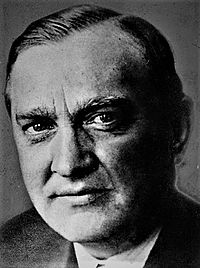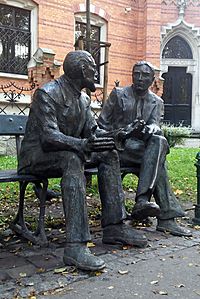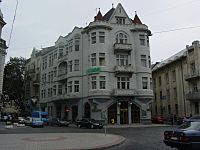Stefan Banach facts for kids
Quick facts for kids
Stefan Banach
|
|
|---|---|
 |
|
| Born | 30 March 1892 |
| Died | 31 August 1945 (aged 53) |
| Alma mater | Technical University of Lwów |
| Known for | Banach space Functional analysis Banach algebra Banach measure Banach–Tarski paradox Banach fixed-point theorem Banach–Steinhaus theorem Banach–Mazur theorem Banach–Schauder theorem Hahn–Banach theorem Banach–Alaoglu theorem Surjection of Fréchet spaces |
| Awards | Membership: Polish Academy of Learning |
| Scientific career | |
| Fields | Mathematics |
| Institutions | University of Lwów |
| Doctoral advisors | Hugo Steinhaus Kazimierz Twardowski |
| Doctoral students | Stanisław Mazur |
| Other notable students | Józef Schreier Stanislaw Ulam |
Stefan Banach (pronounced: Steh-fahn Bah-nakh; born March 30, 1892 – died August 31, 1945) was a very important Polish mathematician. Many people think he was one of the most influential mathematicians of the 20th century. He started a new area of math called functional analysis. He was also a key member of the Lwów School of Mathematics. His most famous work was a book from 1932. It was called Théorie des opérations linéaires (Theory of Linear Operations). This was the first major book on functional analysis.
Stefan Banach was born in Kraków, Poland. He loved solving mathematical problems even when he was in school. After finishing school, he became friends with Hugo Steinhaus. Together, they started the Polish Mathematical Society in 1919. They also launched a science magazine called Studia Mathematica. In 1920, he became an assistant at the Lwów Polytechnic. He became a professor in 1922 and joined the Polish Academy of Learning in 1924. Banach also helped create the Lwów School of Mathematics. This was a group of very famous Polish mathematicians. They worked together between World War I and World War II.
Many important math ideas are named after Banach. These include Banach spaces, Banach algebras, and the Banach–Tarski paradox. Other famous ideas are the Hahn–Banach theorem and the Banach fixed-point theorem.
Contents
Life of Stefan Banach
Early Years
Stefan Banach was born on March 30, 1892. This was at St. Lazarus General Hospital in Kraków. At that time, Kraków was part of the Austro-Hungarian Empire. His parents were Stefan Greczek and Katarzyna Banach. They were from the Podhale region. His father was a soldier. Not much is known about his mother.
It was unusual that Stefan used his mother's last name, Banach. Soldiers of his father's rank were not allowed to marry. His mother was also very poor. So, his parents decided that family and friends would raise him. Stefan lived with his grandmother for a few years. When she got sick, his father arranged for him to live with Franciszka Płowa and her niece Maria Puchalska in Kraków. Stefan thought of Franciszka as his foster mother. He saw Maria as his older sister.
When he was young, Stefan had a tutor named Juliusz Mien. Mien was a French thinker who lived in Poland. He taught Banach French. He probably also encouraged his early interest in math.
In 1902, when he was 10, Banach went to Kraków's IV Gymnasium. This school focused on humanities. But Banach and his best friend Witold Wilkosz, who also became a mathematician, spent their time on math problems. They worked on them during breaks and after school. Banach later said that his math and physics teacher, Dr. Kamil Kraft, sparked his interest in math.
After high school in 1910, Banach moved to Lwów (now called Lviv). He wanted to study at the Lwów Polytechnic. He first chose engineering. He thought there was nothing new to discover in math. He also sometimes attended Jagiellonian University in Kraków. He had to earn money for his studies. So, he didn't pass his high school exams until 1914, when he was 22.
When World War I started, Banach did not have to join the army. This was because he was left-handed and had poor eyesight. When the Russian Army attacked Lwów, Banach went to Kraków. He stayed there for the rest of the war. He worked as a tutor and in a bookstore. He also supervised a road-building team. He attended some lectures at Jagiellonian University. Famous Polish mathematicians like Stanisław Zaremba taught there.
Meeting Hugo Steinhaus
In 1916, Stefan Banach met Professor Hugo Steinhaus. This happened in Kraków's Planty park. Steinhaus was a well-known mathematician. Steinhaus said he heard someone talking about "Lebesgue integral." This was a new math idea. He went to see who it was. That's how he met Banach and Otto Nikodym. Steinhaus was very impressed by Banach. Banach had taught himself a lot of math.
This meeting led to a long friendship and working relationship. Steinhaus asked Banach to solve some difficult math problems. Banach solved them in just one week. Soon, they published their first paper together. Steinhaus, Banach, and Nikodym, along with other mathematicians, started a math society. This group officially became the Polish Mathematical Society in 1919. Banach also met his future wife, Łucja Braus, through Steinhaus.
Between the World Wars
Steinhaus helped Banach a lot in his career. After Poland became independent in 1918, Banach got a job at the Lwów Polytechnic. With Steinhaus's support, he earned his doctorate degree. He did this even though he hadn't finished university in the usual way. His doctoral paper was accepted in 1920 and published in 1922. It contained the main ideas of functional analysis. This soon became a brand new area of mathematics. In his paper, he defined what we now call a Banach space.
His work was talked about a lot in the math world. In 1922, he became a professor at the Lwów Polytechnic. He got his own special teaching position in 1927. In 1924, he became a member of the Polish Academy of Learning. At the same time, from 1922, Banach also led the second Math Department at University of Lwów.
Banach was young and very talented. He gathered many mathematicians around him. This group met at the Scottish Café. They soon formed the "Lwów School of Mathematics." In 1929, the group started their own journal, Studia Mathematica. It focused on functional analysis, Banach's main area of study. Around this time, Banach also started his most famous book. It was the first big book on the general theory of linear-metric spaces. It was first published in Polish in 1931. The next year, it was translated into French. This made it famous across Europe. This book was also the first in a long series of math books edited by Banach and his group. In 1924, Banach became a member of the Polish Academy of Sciences and Fine Arts.
World War II and Later

After Nazi Germany and the Soviet Union invaded Poland in 1939, Lwów came under Soviet control. Banach was a member of the Academy of Sciences of Ukraine. He was also on good terms with Soviet mathematicians. He had to promise to learn Ukrainian to keep his job.
In 1941, Germany took over Lwów during Operation Barbarossa. All universities were closed. Banach, many of his colleagues, and his son worked at Professor Rudolf Weigl's Typhus Research Institute. They were "lice feeders." This job protected many university professors from being arrested or sent to Nazi concentration camps.
In 1944, the Soviet Red Army took back Lviv. Banach returned to the University. He helped restart it after the war. But the Soviets were moving Poles out of these areas. So, Banach planned to move to Kraków, Poland. He was offered a job at the Jagiellonian University. He was also considered for Minister of Education of Poland. In January 1945, he was diagnosed with lung cancer. He was allowed to stay in Lwów. He died on August 31, 1945, at age 53. Hundreds of people attended his funeral at the Lychakiv Cemetery.
Banach's Contributions to Math
Banach's doctoral paper, finished in 1920, was very important. It formally defined a "complete normed vector space." This laid the groundwork for functional analysis. In his paper, Banach called these spaces "class E-spaces." But in his 1932 book, Théorie des opérations linéaires, he called them "spaces of type B." This likely led to them being named Banach spaces after him. Other mathematicians like Frigyes Riesz and Hans Hahn also worked on similar ideas. For a short time, these spaces were even called "Banach–Wiener" spaces.
Banach's fixed point theorem was also in his doctoral paper. It was based on earlier work by Charles Émile Picard. His students and other mathematicians later expanded on it. This theorem did not need the space to be linear. It worked for any complete Cauchy space.

The Hahn–Banach theorem is one of the most important theorems in functional analysis. Other theorems linked to Banach include:
- Banach–Tarski paradox
- Banach–Steinhaus theorem
- Banach–Alaoglu theorem
- Banach–Stone theorem
How Stefan Banach is Remembered
In 1946, the Stefan Banach Prize was created by the Polish Mathematical Society. In 1992, the Institute of Mathematics of the Polish Academy of Sciences started the Stefan Banach Medal. This medal is for great achievements in math. Since 2009, the International Stefan Banach Prize has been given to young mathematicians. It rewards the best doctoral papers in math.
Stefan Banach has many schools and streets named after him. These are in cities like Warsaw, Lviv, and Kraków.
In 2001, a small planet was named 16856 Banach after him. Paul Comba discovered it in 1997.
In 2012, the National Bank of Poland honored Banach. They made special coins with his image. These included a golden 200-zloty coin.
In 2016, a special bench was put in Kraków's Planty Park. It features Banach and Otto Nikodym. This was 100 years after they met Hugo Steinhaus there. That meeting was very important for Banach's career.
In 2021, a Polish TV show called Geniusze i marzyciele (Geniuses and Dreamers) featured Stefan Banach.
In 2022, Google Doodle celebrated the 100th anniversary of Banach becoming a professor.
Images for kids
-
Banach monument, Kraków
See also
 In Spanish: Stefan Banach para niños
In Spanish: Stefan Banach para niños
- Closed range theorem
- International Stefan Banach Prize
- List of Poles
- List of Polish mathematicians
- List of things named after Stefan Banach




